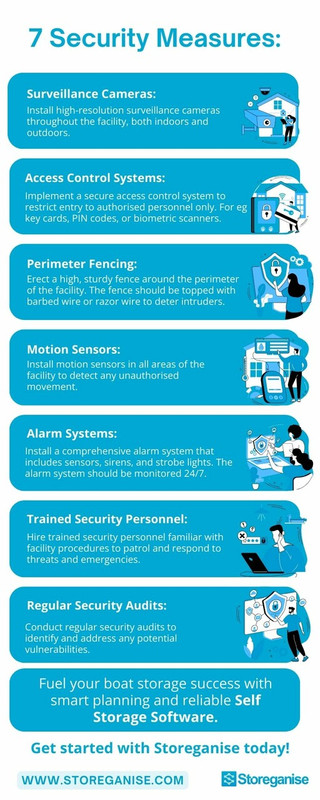Building a Boat Storage Facility: Ultimate 2026 Guide
Learn essential steps and tips for launching and managing a successful boat storage facility in this comprehensive 2026 guide.

Welcome to our ultimate guide on setting up a boat storage facility! Whether you’re a boat enthusiast, a marina owner, or an entrepreneur looking to start a new boat storage facility, this in-depth guide provides all the essential information you need to create a state-of-the-art storage facility for boats of all shapes and sizes.
Having worked with the largest self storage facilities across the world, the Storeganise team has done key research on the boat storage industry to put together this guide. This post covers everything from design considerations and construction tips to security measures and cost analysis. Prepare to embark on a journey to create the perfect haven for boats, where owners can store their prized possessions with peace of mind.
Download the ultimate Self Storage e-book
Everything you need to know about setting up your self-storage facility.
Prerequisites: Understanding the Boat Storage Industry
If you’re considering how to start a boat storage business, it’s essential to have a solid understanding of the market first. The demand for boat storage facilities has increased, driven by many boat owners needing safe and secure storage options. Whether due to limited home space or the desire for professional maintenance and security, boat storage facilities play a crucial role in meeting these needs.
As you delve into the boat storage industry, it’s essential to:
-
Conduct thorough market research to identify boat owners’ specific demands and preferences in your target area.
-
Understand the local boating community and their storage requirements, as that will provide valuable insights for tailoring your business to meet their needs effectively.
-
Stay informed about self storage industry statistics, trends and regulations, as that will help you confidently navigate the market and make informed decisions for your boat storage lot.
Having understood the state of the boat storage industry and what to expect going forward, let’s now delve into how you can build a successful boat storage business.
3 Steps to Building a Boat Storage Business
Building a successful boat storage business goes beyond understanding how the industry works; it requires careful planning and strategic execution.
Here are 3 steps to follow:
- Craft a business plan.
- Secure funding.
- Obtain permits and licenses.
Step 1: Craft a Business Plan.
The first step is to develop a comprehensive business plan that outlines your goals, financial projections, target market, and operational strategies. This plan will serve as a roadmap for your venture and provide a clear direction for your business activities.
Step 2: Secure Funding.
Once your business plan is in place, the next crucial step is to obtain the necessary funding for your boat storage facility. Whether through personal investments, loans, or partnerships, having a solid financial foundation is essential for acquiring land, constructing storage facilities, and implementing security measures.

Step 3: Obtain Permits and Licences.
Additionally, obtaining the required permits and licences is vital to ensure that your business complies with legal and regulatory standards.
These 3 steps serve as the foundational blocks to building a viable boat storage facility. However, there are other vital factors that you must consider, like location, facility design and layout, marketing, security, etc. We’ll start with location below, analysing important things to look out for before picking a site.
3 Factors to Consider When Selecting a Location
The success of your boat storage facility hinges significantly on its location.
A prime site should be:
-
Easily accessible to boat owners: Accessibility to major roads and highways is essential for convenient transportation of boats to and from your facility.
-
Ideally located near popular water bodies or marinas: Conducting a thorough feasibility study of potential locations will help you assess the competitive landscape. A great recommendation is to search for “boat storage near me” on Google. This will offer insights into those marina locations where boat and RV storage services are in high demand.
-
Compliant with legal regulations: It’s also important to examine the local zoning regulations and storage unit laws to ensure your chosen site aligns with all legal requirements and environmental considerations.
By carefully evaluating these factors, you can identify the perfect site that offers the best potential for success and growth for your boat storage business. However, securing a good location is just one step of the process; you must construct the boat storage facilities to standard — the next section outlines how to go about this.
4 Key Considerations for Boat Storage Facility Construction
Once you’ve secured the ideal location for your boat storage facility, the next step is to assess the storage building costs and embark on the construction phase.
Here are 4 important considerations:
-
Collaborating with experienced architects, engineers, and boat storage building professionals can help you efficiently bring your vision to life.
-
During construction, prioritising durable and weather-resistant materials is essential to ensure the longevity and quality of your storage facilities.
-
Incorporating environmentally sustainable practices into your construction process can enhance the appeal of your boat storage facility and demonstrate your commitment to eco-friendly operations.
-
Implementing energy-efficient lighting, water-saving technologies, and eco-conscious building materials can help reduce operational costs in the long run.
Having conducted cost and construction assessments, the next step is to design your boat storage facility. Keep reading to discover our 6-point recommendation list when it comes to the design and layout of a boat storage facility.
A 6-Point Checklist for Boat Storage Facility Design and Layout
The design and layout of your boat storage facility play a significant role in the overall customer experience and operational efficiency.
We recommend adhering to this 6-point checklist when planning the layout:
- Maximise storage capacity.
- Provide ample space for boat manoeuvring.
- Integrate convenient access points for owners and staff.
- Optimise the layout for easy navigation and efficient boat retrieval and storage.
- Incorporate designated areas for maintenance and repairs within your facility.
- Offer on-site maintenance and repair services.
After finalising the design and layout of your boat storage facility, it’s time to determine how to price the various services you plan on offering. In the next section, we outline the important cost considerations to look into.
3 Pricing and Cost Considerations for Boat Storage
Setting the correct pricing structure for your boat storage facility requires a careful balance between profitability and competitive pricing.
Consider these 3 strategies when setting prices:
-
Conduct a thorough analysis of your operational costs, including land lease or purchase, construction costs, maintenance, and staffing. This is crucial for determining the pricing that will cover your costs while remaining attractive to potential customers.
-
Consider the seasonal nature of boat usage, offering flexible storage options, such as short-term and long-term contracts, that can accommodate the varying needs of boat owners throughout the year.
-
Provide value-added services, such as on-site maintenance, cleaning, and winterisation, to justify premium pricing and set your facility apart from competitors.
Tip: While setting competitive pricing has its benefits, you may discover it eats deep into your profit. Managing boat and RV storage facilities can be costly, which is more reason why you need an optimal self storage management software to increase operational efficiency and reduce costs. That way, you can always offer competitive prices without affecting your profit.
The majority of the steps discussed so far in this guide have been tailored to investors and entrepreneurs looking to build a boat storage facility from scratch. The truth is not everyone will want to go through this long process when you can simply buy an existing boat storage business and modify it as needed. If you choose to follow this route, check out the next section for important considerations worth looking into.
A 5-Point Checklist for Purchasing a Boat Storage Business for Sale
If you’re considering acquiring an existing self storage facility, you should consider the following:
- Carry out thorough due diligence to assess the business viability and potential for growth.
- Evaluate the current financial performance, customer base, facilities, and reputation of the business to provide valuable insights into its value and prospects.
- Examine the terms of the sale, including any existing contracts, liabilities, and operational details, for an informed buying decision.
- Seek professional guidance from business brokers, legal advisors, and financial experts to help you confidently navigate the process of acquiring a boat storage business.
- Conduct a comprehensive assessment of the market and competitive landscape to enable you to identify opportunities for expansion and improvement, ensuring that your investment in a storage business aligns with your long-term goals.
Now that you’re all set with your boat storage business, you should make a conscious effort to get the word about it out there via proper marketing strategies, as we’ll observe in the next section.
4 Tips for Marketing Your Boat Storage Business
Effective self storage marketing is essential for attracting customers to your boat storage facility and establishing a solid brand presence.
Consider these 4 tips to market your boat storage business:
-
Leverage digital marketing strategies—including search engine optimisation (SEO), social media marketing, and targeted online advertising—to help you reach a wider audience of boat storage warehouse owners and enthusiasts.
-
Create engaging and informative content like blog posts, videos, and infographics to showcase your storage facility’s unique features/benefits and drive interest and inquiries from potential customers.
-
Establish partnerships with local marinas, boat dealers, and marine service providers to expand your reach and generate valuable referrals for your business.
-
Host open house events, participate in boat shows, and sponsor boating events. These are effective ways to connect with the boating community and showcase the unique selling points of your boat and RV storage facility.
As your boat storage business attracts customers, it’s important to take the necessary steps towards securing it. By taking security seriously, you can enjoy increased customer trust and, by extension, loyalty.

7 Security Measures for Boat Storage Facilities
Considering how often storage units get broken into, ensuring the safety and security of the stored boats is a top priority for any boat storage facility.

Here are 7 storage facility security solutions to incorporate:
-
Surveillance cameras: Install high-resolution surveillance cameras throughout the facility, both indoors and outdoors. These cameras should be motion-activated and recorded in high definition, preferably.
-
Access control systems: Implement a secure access control system to restrict entry to authorised personnel only. This could include key cards, PIN codes, or biometric scanners.
-
Perimeter fencing: Erect a high, sturdy fence around the perimeter of the facility. The fence should be topped with barbed wire or razor wire to deter intruders.
-
Motion sensors: Install motion sensors in all areas of the facility to detect any unauthorised movement. These sensors should be connected to an alarm system that will alert security personnel.
-
Alarm systems: Install a comprehensive alarm system that includes sensors, sirens, and strobe lights. The alarm system should be monitored 24/7 by a central monitoring station.
-
Trained security personnel: Hire trained security personnel to patrol the premises and respond to any threat. These personnel should be familiar with the facility’s security procedures and be able to handle emergencies.
-
Regular security audits: Conduct regular security audits to identify and address any potential vulnerabilities. These audits should be conducted by a qualified security professional.
Conclusion
Building and operating a successful boat storage facility requires careful planning, strategic decision-making, and a deep understanding of the industry and customer needs. Whether you’re starting a new boat storage unit business or looking to expand an existing one, the steps, tips and insights provided in this guide can serve as a valuable resource for achieving success in the boat storage industry. Most importantly, ensure you adopt a reliable self storage software to streamline business operations and automate processes.
Frequently Asked Questions
How Many Square Feet Do You Need To Store a Boat?
While a 250 sq ft unit can store a small boat with extra space for other items, the exact amount of square feet you’ll need to store a boat will depend on the boat’s size. For small-sized fishing boats measuring less than 20 ft in length, a 10 x 20 storage unit will suffice. However, larger boats may require much bigger storage units measuring up to 20 x 40.
How Much Does It Cost To Store a Boat in a Marina?
The average cost to store a boat in a marina is £40 to £200 per month. The actual amount will depend on factors like storage location, boat size, storage type, etc.
Can You Store a Boat on Land?
Yes, you can store a boat on land, including on a boat storage yard, storage facilities, or private property. We recommend opting for boat storage buildings, especially those with an excellent self storage software that allows for contactless booking and automated billing.
How Do I Keep My Boat Dry in Storage?
To keep your boat dry in storage, consider options such as mechanical ventilation, passive vents, solar-powered vents, and more powerful electric vents. Adequate ventilation through the boat’s interior spaces is crucial to prevent moisture buildup, which can lead to mould and mildew, causing damage to the interior materials. Proper boat maintenance is also crucial to avoid costly repairs.
